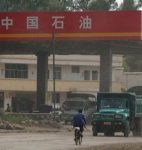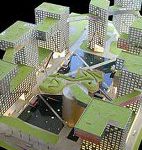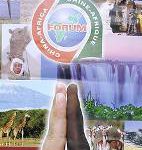China’s many varieties of grassland cover an area of 1 billion acres. They account for 41% of the country’s total area, and are 3.3 times the size of its cropland. Yet these vast grasslands cannot feed the animals they are home to, which together account for one-third of China’s livestock. Many years of overgrazing have led to the deterioration of 90% of China’s grasslands, giving rise to environmental problems such as sandstorms.
Ecologists sometimes refer to the “10% rule”: that 10% of the energy of a primary producer should be passed on to a secondary producer. This means that under good environmental conditions, the world’s green vegetation totals about 200 billion tonnes (pure carbon), of which around 10% will be eaten by herbivorous animals. The dry weight of vegetation on China’s grasslands is 300 million tonnes, leaving about 30 million tonnes for grazing if the ecosystem were undamaged. But the methods currently used to calculate grassland capacity are flawed, and overgrazing is widespread. Actual numbers of livestock are far above even ‘theoretical’ thresholds, and the grasslands have inevitably deteriorated. How can this pressure be relieved and the grasslands allowed to recover?
The answer lies not with the grasslands, but in China’s cropfields. Aside from producing 500 million tonnes of food, China’s 167 million acres of farmland also produce over 700 million tonnes of straw. Corn, wheat and rice make up 38%, 22% and 19% of the total straw, respectively. Other crops produce smaller proportions, such as legumes (4.8%), tubers (2.8%) and rapeseed (8.3%). Of this straw, 94.9% can be used as fodder. In fact, all of China’s straw could provide 22 times as much fodder as the grasslands can reasonably provide. And using technology to double the value of the fodder could feed all of China’s livestock.
Unlike on the grasslands, if straw is eaten by sheep and cattle it can be returned to the land in the form of manure or residue from biogas production. Not only will the land be unharmed, but it will also be fertilised. Livestock production should be moved south, from the arid grasslands of traditional herding areas in Inner Mongolia, Tibet, Xinjiang and Qinghai to the food-producing provinces of Shandong, Henan, Hebei, Sichuan and Hunan.
China has 4.7 billion chickens, and an annual demand of 3.7 chickens per person per year. But farmers squeeze chickens into wire cages and overuse additives to fatten them up as quickly as possible. This makes them ready for slaughter in 45 days, as opposed to the 300 days of a free-range chicken. These unnatural meat-production methods are contributing to obesity in our cities. They are aiding the spread of avian flu that endangers food safety and public health, and are inviting criticism of China’s record on animal-welfare issues. The wide open spaces poultry need are not to be found in farmyards, much less in wire cages; the space is out on the grasslands. Chickens present no danger to the grassland, and can help control pests. In the future, the huge quantities of chicken and eggs that China needs should come from the grasslands.
Tragically, all this potential livestock fodder is now treated as waste and burned off in the fields, despite regulations to the contrary. There is currently no way to use the straw, and so the law is ignored. But if full use was made of the straw, the value added could be five to 10 times the worth of the grain itself.
Farmland in places like Shandong can produce about one tonne of grain per mu (0.17 acres) of land. After costs, this can bring in an income of around 500 yuan (US$64), less than a migrant worker in China’s cities will earn in a month. But if three tonnes of fodder could be harvested at the same time, it would feed an adult cow for 150 days. Cows could bring an extra 2,700 yuan (US$345) of value per mu, and raising dairy cows would be more profitable still.
From ancient times until recent years, straw was used as fuel or to feed draft animals that ploughed the fields. Now tractors have replaced draft animals; chemicals have replaced organic fertilisers; and coal and gas have replaced straw as fuel. But tractors don’t produce manure, and chemical fertilisers are dangerous, causing pollution, losses in soil fertility and increasing costs for farmers.
Apart from the material waste, the loss of energy is also significant. Although for many years China has advocated the use of biogas, high costs and a scarcity of manure has made government support ineffective. But the use of straw as feed, can provide an efficient new source of power, as manure is used to make biogas and biogas residue is used to fertilise crops.
Straw must be processed into fodder to supply livestock feed, to provide energy from biogas and ensure China’s sustainable agricultural development. There are huge profits to be shared not only between crop farmers and livestock farmers but also the transportation, processing and organic fertiliser industries. The power and service sectors can also benefit, all of which will be linked together by the invisible hand of the market.
There is no better way to deal with grassland deterioration, pests, food safety and the risk of avian flu than raising chickens on open grassland. In 2005, I carried out an experiment in Inner Mongolia’s Zhenglan Banner, and found that it is possible to raise 15,000 chickens on 300 mu (50 acres) of land. After expenses and labour, income from each mu (0.16 acres) was 50 yuan (US$6), over 50 times the income of traditional herding (one mu of damaged grassland in Inner Mongolia brings in less than 10 yuan.)
Raising livestock in crop-growing regions presents problems with the transportation, storage and the conversion of straw into feed. These problems can be resolved through new technology, using innovations in microorganisms, enzymes and processing to ferment and package straw into bales of fodder. The city of Laixi, in eastern China’s Shandong province, already collects all its straw for use and does not burn it. Raising chickens in herding areas will face no market problems if urban consumers will opt for free range chickens over caged birds. And if the price is similar, they will.
The Chinese government should research the idea of moving livestock south and chickens north. Model projects should be established in the south and the north, using technology and the market to promote China’s economic growth and sustainable development.
Jiang Gaoming is a professor at the Chinese Academy of Sciences’ Institute of Botany and a doctoral candidate tutor, vice secretary-general of the United Nations Educational, Cultural and Scientific Organisation’s China-MAB (Man and the Biosphere) Committee and member of the UNESCO MAB Urban Group. He is recognised for his introduction of the concepts of urban vegetation and using natural forces to restore China’s ecosystems.





